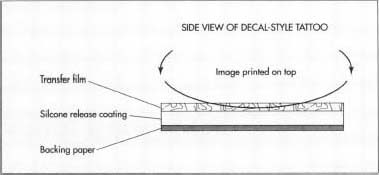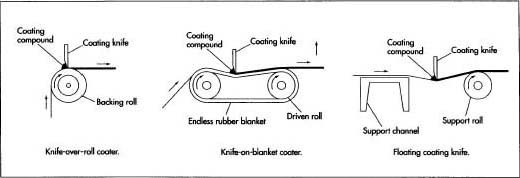Temporary Tattoo
Background
A temporary tattoo is a decorative image that can be applied to the skin for short periods of time. Most temporary tattoos are novelty items made with a special type of decal. A process known as screen printing is used to create the tattoo image on paper coated with a transfer film. The transfer film allows the image to "slide" off the backing paper and onto the skin when moisture is applied. After drying, the film holds the image on the skin through several washings.
For centuries, men and women have added decorative illustrations to their skin for religious or cultural reasons. One common method of decorating skin is tattooing, a process which involves injecting patterns of dye directly into the skin using a needle. Although this technique was originally practiced in ancient Egypt, the term tattoo is actually derived from a Tahitian word that was most likely spread by sailors in the Pacific. Many other cultures have their own unique tattoo techniques. For example, Eskimos use bone needles to draw soot-covered thread through the skin and the Japanese use fine metal needles to deliver colored pigments. Regardless of which technique is used, all tattoo processes deposit colorants below the surface of the skin to create intense, permanent images. While tattooing remains a popular art form today, it is also expensive, time consuming, and may be somewhat painful. For these reasons, permanent tattoos are not necessarily desirable for every individual.
Temporary tattoos were created as an alternative way for individuals to decorate their skin. Temporary images can be produced by several methods. For example, they can be hand drawn and painted using a brush with water insoluble dyes or pigments. Although this method requires a talented artist to create a high quality image, it does produce a picture which can be removed fairly easily. A better way of achieving a temporary tattoo is by decalcomania, which is the process of applying a decal to the skin. This approach allows the user to apply a preprinted image to the skin at their convenience. Decal-style tattoos are so simple to apply that even a child can use them and the image that is produced can be easily removed with soap and water. Therefore, temporary tattoos can be easily changed to suit the whims of fancy and fashion. Decal-style temporary tattoos are made by printing an image onto special paper coated with a transfer film. To apply the tattoo the user simply moistens the paper and the film slides off the backing layer carrying the image onto the skin.
Raw Materials
Stencil materials
Tattoos can be made by a screen-printing process, which uses stencils to create the image to be printed. These stencils are made from nonporous paper or plastic coated with lacquer, gelatin, or a combination of glue and tusche (a heavy ink-like substance). These materials are used to block portions of the screen during the printing process so the ink only touches the paper in designated spots.
Inks
Because temporary tattoos reside on the skin for relatively long periods of time, all

Backing paper
Temporary tattoos may be printed on paper, plastic films, or combinations of the two. Paper is generally preferred because it is better for printing and processing. This backing paper is coated with a variety of materials using spraying or dipping methods. The coatings can be processed to a uniform thickness by passing the coated paper through a series of rollers outfitted with a knife, which evenly spreads the liquid. The paper can then be passed through a heated tunnel to accelerate drying. The first coating that is applied is typically a sizing agent, which modifies the paper's stiffness and texture. The next layer is a non-stick silicone release coating which helps the image separate from the backing paper. A transfer film is then coated on top of the silicone layer. This film is the layer that the image is printed upon and is composed of gelatin or other polymeric materials such as polyvinyl alcohol or polyvinyl pyrollidone. These materials are designed to be strong enough to adhere to the backing paper during printing yet flexible enough to be easily released during application. Upon drying on the skin, the film should adhere tightly and smoothly to maintain the image quality.
The Manufacturing
Process
Stencil preparation
- 1 An outline of the image to be printed is cut into the gelatin or lacquer layer of the stencil sheet. The lacquer or gelatin is peeled away to expose the areas to be printed. The stencil is then adhered to the screen with a solvent and, after it has dried on the screen; the backing sheet is removed leaving only the film layer. The portions of the stencil that were cut away expose a section of the screen through which ink can be forced.
Screen printing
- 2 The screen to which the stencil is adhered is typically made of finely woven fabrics (like silk, nylon, and Dacron) or stainless steel mesh. Image transfer is accomplished by forcing the inks through the stencil and onto the printing substrate. A rubber squeegee is used to force ink through openings in the stencil. In this process, only one color can be printed at a time, so the image must pass through the screen press once for every color. The colors are laid down in reverse order, from last to first so the finished tattoo resembles a multilayer sandwich. The bottom layer is the release paper, followed by the transfer film, topped with the detail colors. The background colors are laid down last.
Finishing operations
-
3 If necessary, the printed tattoo sheets can be coated with another
layer of film-forming material to seal in the image. After
this final coating step the sheets are cut, or slit, into rolls or individual tattoos. The finished tattoos are then wrapped or boxed for shipping. The packaging materials should be designed to minimize contact with moisture to avoid premature softening of the transfer film.
 Once printed, the temporary tattoo can be coated with a release coat and transfer film in three ways.
Once printed, the temporary tattoo can be coated with a release coat and transfer film in three ways.
Transfer process
- 4 Tattoos are easily transferred from the printed sheet to skin by first lightly dampening the skin. Care must be taken not to saturate the tattoo because the film may begin to dissolve before the image is transferred. The backing paper is then firmly held against the skin either by hand or with a damp cloth or sponge. The paper must be held still to avoid shifting the image during transfer. After one to three minutes the transfer layer will soften and separate from the backing paper. The paper can then be easily peeled away, leaving the transfer film and the printed image intact on the skin. As the film dries, it bonds firmly to the skin.
Quality Control
A number of factors affect the quality of temporary tattoos. First, the stencil must be properly prepared because dull or poor tooling will result in a murky image. Similarly, the printing screen must be carefully maintained to keep ink from clogging the pores in the screen. Inks must be correctly compounded because if they are too thick or too thin they will not pass through the screen properly. Finally, the components of the backing paper must be properly prepared.
The sizing agents, the silicone release layer, and the transfer film must all be coated evenly to minimize problems during printing and to ensure even image transfer. After manufacture is complete, the finished tattoos must be carefully packaged to exclude moisture which could cause ink bleeding or premature softening of the transfer film.
Byproducts/Waste
The decal manufacturing process creates waste in the form of excess lacquer, gelatin, paper, and inks. Some of these waste materials may be flammable or hazardous depending on the solvents used. In many cases, paper may be recycled by repulping, a process which involves shredding the paper and mixing it with water to wash off residual coatings. The repulped paper can be cast into sheet form again and reused to make new tattoos. For all the waste that is generated, manufacturers must comply with all relevant local and federal waste disposal regulations.
The Future
Advances in printing technology are likely to improve tattoo manufacturing processes. One advance that is likely to impact the industry is the use of computer-aided printing technologies, such as ink-jet printing. It is anticipated that ink jet printers could be used to quickly and easily produce decal-style tattoos. However, such printing improvements may not solve the problem of image degradation. Image degradation occurs because of the motion, expansion, and contraction of the skin, all of which causes tiny fractures in the image film layer. Even though the film remains adhered to the skin, the image quality is severely reduced due to the visible cracks and creases. A recent patent suggests this problem can be solved by using alcohol soluble, water insoluble dyes and a special transfer solution to help maintain the integrity of the transfer film. Reportedly this process results in an improved, longer lasting image. Another patented way to achieve improved temporary tattoos uses an adhesive to hold pictures on the skin. This approach produces an image on a translucent adhesive substrate that can be adhered to the body for long periods of time with a minimal loss of image quality.
Other methods of temporarily tattooing the body are gaining popularity. One such technique is Mehndi, the Indian/Pakistani practice of body painting, which uses copper colored ink made from crushed henna leaves. mehndi is becoming widely used in the United States as a way of temporarily adorning the body with elaborate scroll-like decorations. Another emerging trend is the use of stencil-like stickers to prevent sun-light from reaching portions of the body during tanning. When these stickers are worn during sunbathing, a temporary tattoo is created because the covered area does not tan like the surrounding skin. While this method is only able to create monochromatic images, it can be used to produce simple lettering and figures.
Where to Learn More
Books
Sanders, C. R. Customizing the Body: The Art and Culture of Tattooing, 1988.
Swerdlow, Robert. The Step by Step Guide to Screen-Process Printing. Prentice-Hall, Englewood Cliffs, 1985.
Other
http://www.zibabeauty.com/home/mehndi.html.
US Patent 4169169. "Transfer Process and Transfer Sheet for use Therein," 1979.
US Patent 4594276. "Printed, Removable Body Tattoos on a Translucent Substrate," 1986.
— Randy Schueller